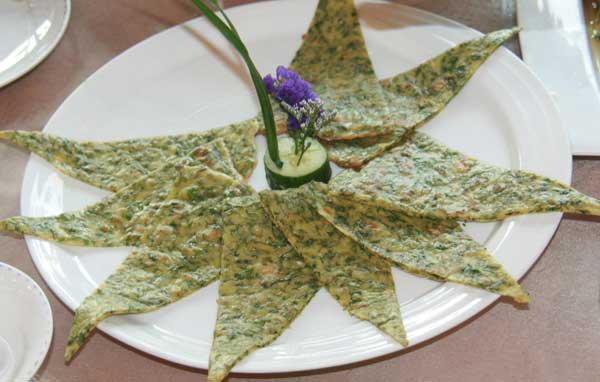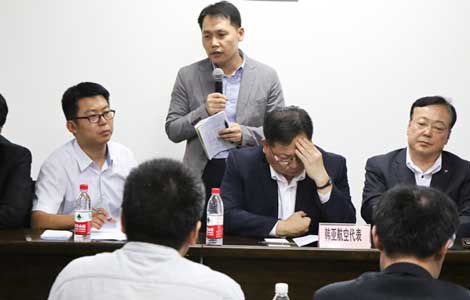
A restaurant in Qingdao has developed a whole line of dishes that include algae, while local authorities are spending a great deal of time and effort trying to wipe out the seaweed.
The algae, enteromorpha prolifera, which have appeared in huge blooms in the coastal waters around the Shandong province city every summer since 2008, have become a burden for local agencies cleaning up beaches. The organisms have had an adverse effect on the ocean environment and local tourism during the peak season in July and August.
 |
|
A dish made of algae. |
Since the restaurant, Liang Chu Fei Chang Hao, introduced its algae dishes last year, customers have praised the offerings.
Restaurant manager Ma Hui said the sauteed egg-algae pancake and algae duck soup are the most popular dishes. However, although the algae are free, they take time to process.
"We launched the algae dishes last year, and our chefs collect algae from nearby beaches," Ma said. "Because the algae are mixed with a great deal of sand, we have to wash the algae by running water for a while, and then soaking them in salt water for another two hours before cooking."
Customer Wang Yan ordered the two dishes for lunch.
"The sauteed egg-algae pancake smells like fresh air from the sea, and it's got tender texture and tastes great. Though the duck soup is tasty, the algae tissue isn't good. It tastes like sponge," Wang told China Daily on Tuesday.
Meanwhile, the algae now have been developed into snacks as well, according to Jinan-based dzdaily.com on Tuesday.
The Shandong Research Institute for Mariculture has successfully added algae to dried fish floss, biscuits and meatballs.
Wang Ying, director of the institute's food center, said the algae are nutritious. They have high protein, high fiber, low fat and many minerals, so they can also be used in medicine and healthcare products.
"Actually, the algae are edible and popular in South China. It would be a waste if we use algae only in feed additives and organic fertilizers. We could use these local materials to develop new food products," Wang Ying added.
As diners care most about the algae's safety, restaurant professionals cite their own advantages of the seaweed.
"Algae are no different than any other edible seaweed as they look almost the same. As long as you clean algae appropriately, they are harmless," Ma said.
Pang Shaojun, a researcher from the Institute of Oceanology of Chinese Academy of Sciences, said that algae are nontoxic, and some dishes made with farmed algae have become popular in China.
However, the algae found in Qingdao traveled a long way, from south to north, so people should be careful while eating algae since there is no guarantee that the seaweed did not become contaminated during the trip, Pang said.
So far, algae are used mainly in three products — feed additives, organic fertilizers and healthcare products. Using algae as cooking ingredients is a new approach.
The Qingdao government said that at 7 am on Tuesday, the algae around Qingdao coastal waters covered 80 square kilometers, and its distribution area, which includes the surrounding area, was 8,442 sq km.
With more than 2,000 people deployed in clean-up operations every day, a total 117,547 metric tons of algae were removed from Qingdao from June 15 to July 15.








